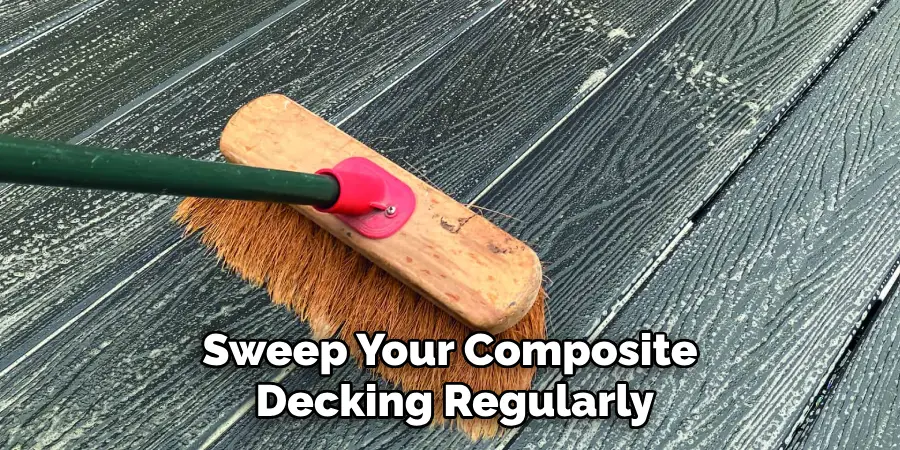Do you have an old composite deck that needs to be disposed of? Are you thinking of replacing your existing composite decking with something more modern and attractive?

If so, a critical step to not overlook is properly disposing of your old decking material. Disposing of composite decking can seem like a daunting task. Fortunately, there are some eco-friendly disposal options available that will help you get rid of your non-recyclable material in the most responsible way possible.
You don’t want it taking up valuable space in a landfill, nor do you want just to let it sit on the curb as an eyesore. Thankfully, there are a few steps on how to dispose of composite decking that can be taken to dispose of any leftover composite decking components environmentally. In this blog post, we’ll provide tips on how to find the proper disposal solution for your composite deck so you can rest easy knowing it’s done safely and sustainably.
Necessary Items for Disposal
- Protective Gear (gloves, goggles, mask)
- Saw or other cutting tool
- Waste Bin or Dumpster
Before you begin the disposal process, it’s essential to gather all necessary items to ensure your safety. Wearing protective gear such as gloves, goggles, and a mask will help protect you from any potential hazards while handling the materials.
Additionally, having a saw or cutting tool on hand will make it easier to break down the composite decking into smaller, more manageable pieces. And, of course, having a waste bin or dumpster available for disposal is crucial.
10 Steps on How to Dispose of Composite Decking
1. Break Down Composite Decking into Smaller Pieces
Using a saw or other cutting tool, carefully cut the composite decking into smaller, manageable pieces. This will make it easier to transport and dispose of.

2. Check Local Disposal Regulations
Before disposing of any materials, check your local disposal regulations. Some areas may have restrictions or specific guidelines for disposing of composite decking.
3. Contact a Professional Disposal Service
If you need help disposing of your composite decking properly, consider contacting a professional disposal service. They will have the knowledge and resources to safely and responsibly dispose of your decking material.
4. Recycle Non-Composite Materials
If your composite decking has non-composite materials such as metal or wood, be sure to separate and recycle these materials accordingly. This will help prevent unnecessary waste in landfills.
5. Use a Construction or Demolition Waste Facility
Another option for disposing of composite decking is to take it to a construction or demolition waste facility. These facilities specialize in handling and adequately disposing of large construction materials.
6. Look into Manufacturer Recycling Programs
Some composite decking manufacturers have recycling programs in place for their products. Research to see if your manufacturer offers this option and how to participate.
7. Donate or Sell Reusable Materials
If your composite decking is still in good condition, consider donating or selling any reusable materials. This will not only help reduce waste but also benefit someone else.
8. Use for Alternative Projects
Instead of disposing of your old composite decking, consider alternative projects where the material can be repurposed. For example, it can be used as a border for garden beds or as a base for raised flower pots.

9. Compost Organic Materials
If your composite decking contains organic materials, such as wood fibers, consider composting them instead of throwing them away. This will help reduce waste and provide valuable nutrients for your garden.
10. Properly Dispose of Any Hazardous Materials
If your composite decking contains hazardous materials, dispose of them properly according to local regulations. This may include taking them to a designated hazardous waste facility.
With these steps, you can confidently and responsibly dispose of your old composite decking. By following eco-friendly disposal practices, you can help reduce waste and protect the environment. As always, check local regulations and guidelines for proper disposal methods in your area. Remember, every little effort counts towards a cleaner and healthier planet. So make sure to recycle, reuse, or repurpose whenever possible!
8 Care Tips to Extend the Lifespan of Your Composite Decking
While proper disposal is essential, it’s also crucial to take care of your composite decking to extend its lifespan. Here are eight tips to help you do just that:
1. Regularly Sweep Debris and Dirt
Sweep your composite decking regularly to remove any debris or dirt that can cause damage over time. This will also help prevent any mold or mildew growth.

2. Clean Up Spills Immediately
If a spill occurs on your composite decking, clean it up immediately. Composite decking can stain easily, so prompt action is crucial to prevent permanent damage.
3. Avoid Using Harsh Chemicals
When cleaning your composite decking, avoid using harsh chemicals that can damage the material. Stick to mild soap and water for gentle yet effective cleaning.
4. Use Mats or Rugs
To help protect your composite decking from scratches, use mats or rugs in high-traffic areas, such as around furniture or grills.
5. Trim Nearby Trees and Shrubs
If you have trees or shrubs near your composite decking, trim them regularly. This will prevent any potential damage from falling branches or excess foliage.
6. Inspect for Any Damage
Regularly inspect your composite decking for any signs of damage, such as cracks or splintering. Address these issues promptly to prevent further damage.
7. Avoid Dragging Heavy Objects
To avoid scratches and damage, avoid dragging heavy objects across your composite decking. Instead, use a dolly or have someone help you lift and carry them.

8. Consider Applying a Protective Coating
To further protect your composite decking, consider applying a protective coating specifically designed for this material. This will help extend its lifespan and maintain its appearance.
Proper disposal and care go hand in hand when maintaining your composite decking. By following these tips, you can not only extend the lifespan of your decking but also contribute to a cleaner and greener environment. So be sure to dispose of your old decking responsibly and take good care of your new one for long-lasting enjoyment.
Frequently Asked Questions
Can Composite Decking Be Recycled?
Yes, some composite decking can be recycled. However, it’s essential to check with the manufacturer for specific instructions and guidelines.
How Often Should Composite Decking Be Cleaned?
Composite decking should be cleaned at least twice yearly or more frequently if heavily used or in high-traffic areas.
Can I Use a Pressure Washer on My Composite Decking?
It’s not recommended to use a pressure washer on composite decking as it can cause damage. Stick to mild soap and water for cleaning.
Are There Any Special Tools or Products Needed to Clean Composite Decking?
No, there are no special tools or products needed for cleaning composite decking. Mild soap and water, a broom, and a mop are sufficient. However, using a plastic shovel instead of metal can help prevent any potential scratching. Always check with the manufacturer for specific recommendations. Additionally, some companies may offer branded cleaning products specifically designed for composite decking.
Can I Install Composite Decking Over an Existing Wood Deck?
It is not recommended to install composite decking over an existing wood deck. The old deck should be removed before installing the new composite decking to ensure proper support and installation.
How Long Does Composite Decking Typically Last?
The lifespan of composite decking varies, but most manufacturers offer a warranty of 25-30 years. Proper care and maintenance can last even longer. However, factors such as climate and usage may affect its lifespan. Be sure to check with the manufacturer for specific information on their product’s expected lifespan.
Can Composite Decking Be Repainted or Stained?
No, composite decking cannot be repainted or stained as it is already coated with a protective layer. However, some manufacturers may offer a limited selection of color options. Check with the manufacturer for more information.
Is Composite Decking Environmentally Friendly?
Composite decking is considered environmentally friendly because it is made from recycled materials and can be recycled at the end of its lifespan. However, it’s important to note that not all composite decking is created equally, and some may contain chemicals or additives that could potentially harm the environment.
Always research and choose a reputable brand that prioritizes eco-friendly practices. Additionally, proper disposal and care practices also play a significant role in the overall environmental impact of composite decking.
Can I Paint or Stain My Composite Decking?
Most composite decking cannot be painted or stained, as it is already manufactured with a color and sealant. Check with the manufacturer for specific instructions and guidelines.
In general, sanding and painting or staining will void any warranty on your composite decking. However, there are some specialized products available that may allow you to change the color or appearance of your composite decking, but these also may void any warranty. Do proper research and consult with the manufacturer before changing your decking. In some cases, repainting or staining may be possible after a certain period has passed since installation.
Final Thoughts
By following eco-friendly disposal practices and proper care tips, you can ensure that your composite decking stays in good condition for years.
Be proactive in maintaining your decking to not only save money on replacements but also to contribute towards a healthier environment.
Remember, every little effort counts! So, let’s all do our part in keeping our planet clean and green. With these tips on how to dispose of composite decking in mind, you can enjoy your beautiful and durable composite decking for many seasons to come.

